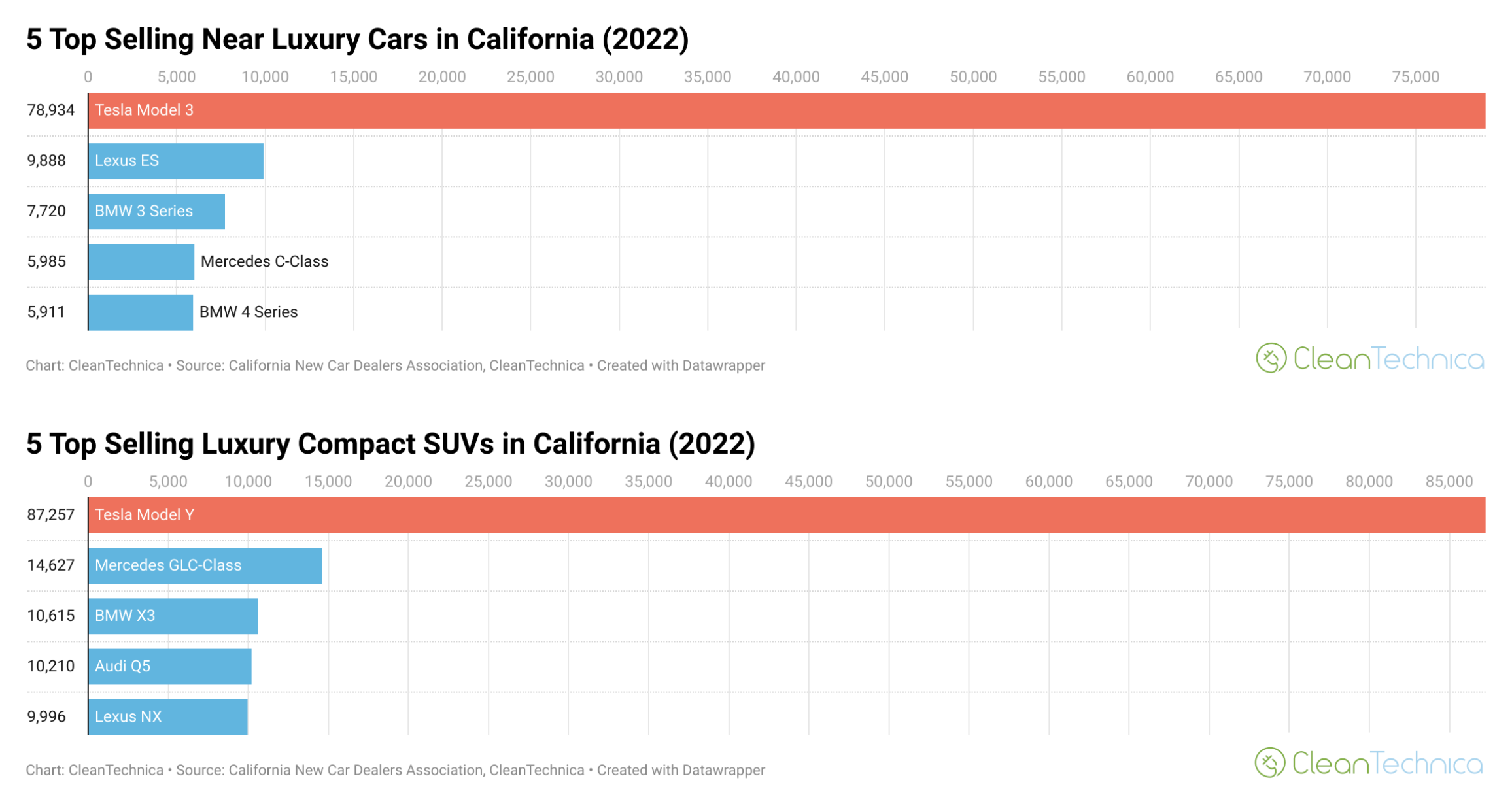Does The Tesla Model 3 Belong In The “Near Luxury Car” Category?
The California New Car Dealers Association recently put out its quarterly — and in this case annual — report on car sales in The Land of Milk and Honey. Tesla’s rise up to #2 seemed to be the story of the year, on the back of the Tesla Model Y and Model 3 becoming the two top selling vehicles of any kind in the state.
The Tesla Model Y and Model 3 becoming #1 and #2 is stunning for a variety of reasons. The fact that Tesla is such a young company is one thing. The fact that they’re electric is another. The fact that this is a giant car market makes the feat all that more impressive. That Tesla was able to scale up production so much to get to this volume is awe inspiring itself. However, there’s another matter that probably stands out above all of those: these models are not in vehicle classes that are supposed to be very high volume.
In the “near luxury cars” class where the California New Car Dealers Association (CNCDA) seats the Tesla Model 3, the midsized sedan had 8 times more sales than the #2 Lexus ES. The chart looks absurd. Clearly, if you were playing the “which of these doesn’t belong?” game, a 3-year-old could answer the question even if all the bars were blue.
In the “luxury compact SUV” class, the Tesla Model Y had 6 times more sales in 2022 than the #2 Mercedes GLC-Class. Again, it doesn’t belong. And there’s no way Mercedes, BMW, Audi, and Lexus like seeing the Model Y in their class.
The purchase price for a Model 3 starts at $43,000. For a Model Y, it’s $55,000. For a new Lexus ES, the base MSRP is $41,340. For the Mercedes GLC-Class, it’s $43,850. So, the Model 3 is right there in the same price range as its top competitor in the “near luxury car” category. It’s hard to argue that it doesn’t belong. The Model Y’s base price is well above that of the GLC-Class — more than $10,000 more! That implies that it really shouldn’t even be competitive in that class.
Looking at the sales of these vehicles, the Model 3 and Model Y should theoretically be competing with lower cost models. But looking at their prices and features and level of comfort, they belong where they are.
There’s one potential caveat. The costs of operating and maintaining electric cars are estimated to be significantly lower than the costs of operating and maintaining fossil fuel cars. Plus, there are potential tax credits and other subsidies that can cut the cost of an EV. According to Tesla’s website, when you go to order these cars, Tesla estimates that the price after savings is $31,290 for the cheapest Model 3 and $42,090 for the cheapest Model Y. In the latter case, that puts the Model Y in the same category as the Mercedes GLC-Class (phew) — but that doesn’t help much in explaining how the Model Y has so many more sales than a “top competitor” in its class. In the case of the Model 3, $31,290 puts it closer to the Toyota Camry (base MSRP of $26,220) or Honda Accord (base MSRP of $27,295). Of course, the Model 3 still outsold them, but it was a much closer competition.
So, the question from the top arises again: does the Tesla Model 3 belong in the “Near Luxury Car” category, or just in the “Midsized Car” category? Tesla cars are so different, and minimalism is such a core design element from inside to outside, that you can’t easily compare design, materials, and features. These are techie cars, the seats are wonderful, and extra gadgets or buttons are minimized. I think the majority of owners would say that Teslas are luxury cars. However, I also know people (and readers) who swear they are not. Is the Model 3 “near luxury,” though? I have to say that I don’t understand the phrase “near luxury” used as a car class — but clearly this is just the low end of luxury car offerings from Mercedes, BMW, Lexus, and, of course, Tesla.
What say you? Does the Model 3 belong in the “Near Luxury Car” category? Does the Model Y belong in the “Luxury Compact SUV” category?
Have a tip for CleanTechnica? Want to advertise? Want to suggest a guest for our CleanTech Talk podcast? Contact us here.
Latest CleanTechnica.TV Video

CleanTechnica uses affiliate links. See our policy here.




